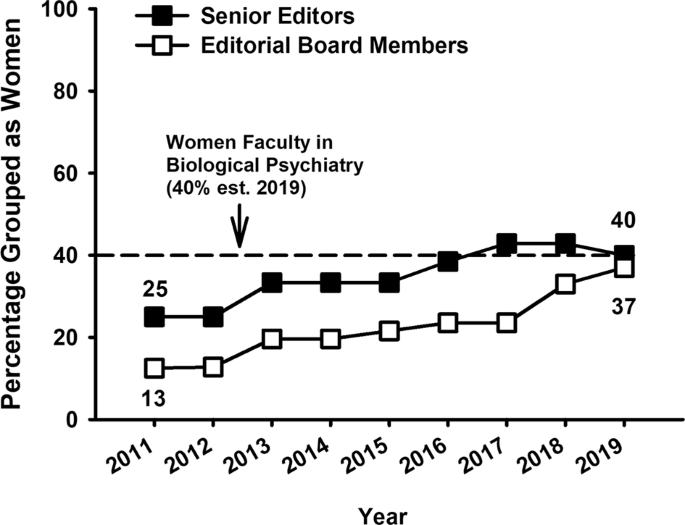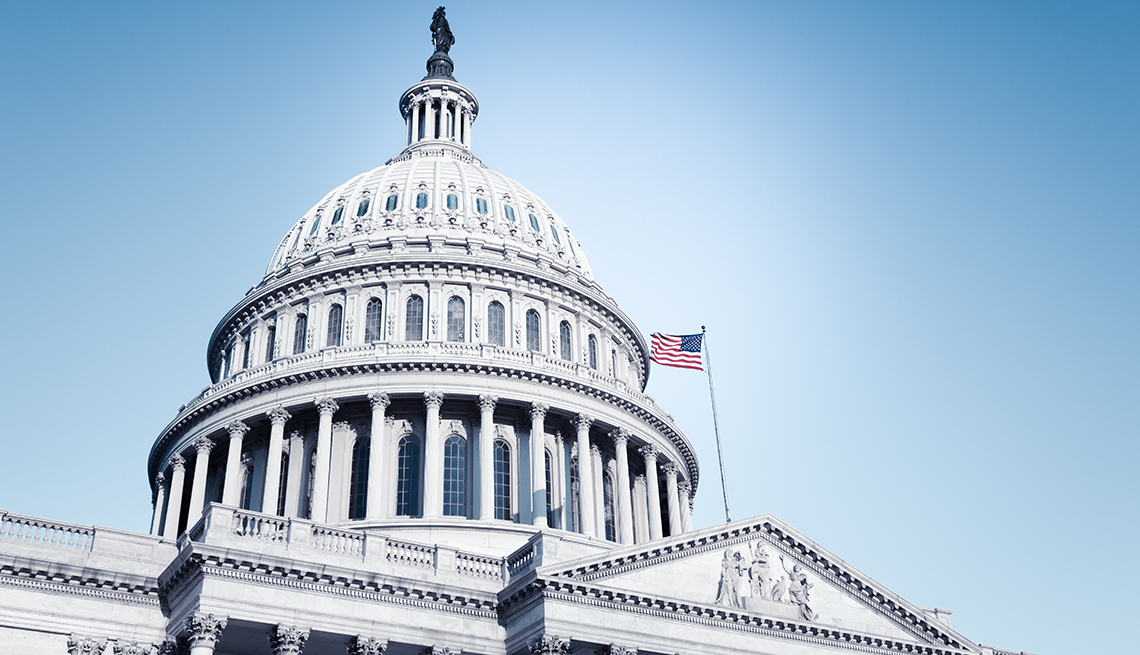
- Select a language for the TTS:
- UK English Female
- UK English Male
- US English Female
- US English Male
- Australian Female
- Australian Male
- Language selected: (auto detect) - EN
Play all audios:
Last year (2018) we provided an initial report on gender balance in NPP (_Neuropsychopharmacology_) function [1]. Specifically, we examined the representation of men and women in editorial,
reviewer, and authorship roles at NPP. Our findings indicated that, in general, gender balance across these roles was encouraging and had been improving over time. We also identified
restricted areas that would benefit from improved gender balance. Here we provide an update on the actions we took and how these metrics have changed over the last year. In our initial
report [1], we used https://biaswatchneuro.com/ to estimate gender balance across our field. We used their estimate for faculty-level ranks, since in general it is faculty members that serve
in the roles that we studied for this special project (i.e., Senior Editors, Editorial Board Members, Reviewers, and Corresponding authors). We acknowledge that by restricting our estimates
to these roles, we may be missing early-career researchers who have engaged in roles that (at least currently) are not typical for trainees. We originally used the estimate of the
proportion of women faculty engaged in neuroscience research (39%) as a proxy for the composition of the ACNP (American College of Neuropsychopharmacology)—the society represented by NPP.
For this update, new data are available for the field of “Biological Psychiatry,” which is a better fit with the full scope of activities of the ACNP membership. Accordingly, here we have
adjusted our estimate of women faculty slightly upward, to 40%. We did not perform statistical analyses on differences between 2018 and 2019 because at this time we are primarily interested
in whether changes are trending toward improvement or deterioration. Updated analysis of Editorial roles indicates that the proportions are at, or very near, the 40% estimate of the
proportion of women faculty in the field (Fig. 1). In particular, for the editorial board—considered to be the journal’s most active and loyal reviewers—there has been a consistent increase
in the proportion of women members that began with the transition to the current journal leadership (in 2013). The current trajectory should enable NPP to exceed estimates of women in our
field within the next 1–2 years. For reviewer roles, we originally collected data in 2018 over a 6-month period (January–June). Updated figures for 2019 cover the exact same 6-month period
(January–June), acknowledging that submission patterns often differ throughout the year. Gender balance in invitations to review (Fig. 2a) and the number of reviews completed (Fig. 2b)
continue to improve and currently approach the 40% estimate for the proportion of women faculty in fields related to the subject matter covered in NPP. As described in our initial report
[1], membership on NPP’s Editorial Board has been based on objective metrics of performance as a reviewer. Because NPP Senior Editors are empowered to use author input for suggested and
excluded reviewers, we explored the possibility that women are less frequently suggested as reviewers during the online submission process. If so, this would create a situation where the
Editorial goal of respecting author suggestions for qualified reviewers has the unintended consequence of fewer women being included in the reviewer pool and ultimately being promoted to the
Editorial Board on the basis of performance metrics. It is important to note that on the basis of the instructions provided to authors during the online submission process, either gender
could hypothetically suggest 100% of their own gender as qualified reviewers. Despite the latitude offered in the process, we discovered that both men and women were far more likely to
suggest men as reviewers (Fig. 3a). In response to this discovery, we instituted a program by which Senior (Handling) Editors were encouraged to be more mindful of gender balance of their
reviewer pool, without mandating strict balance in reviewer proportions. We elected to not mandate a strict balance because, depending upon reviewer availability, this would dramatically
increase the time to complete reviews, which NPP author surveys have revealed as a top priority for the authorship pool. Moreover, we were hesitant to impose any measures that would
over-burden (“tax”) individuals represented in the smaller group. Also, on July 1, 2018 we added a statement to the instructions to authors stating the journal’s goal to promote diversity
across all journal functions and encouraging author participation in this process when constructing their list of suggested reviewers. The specific statements are: “_Please list the names of
6 experts who are knowledgeable in your area and could give an unbiased review of your work_”, and “_NPP Editors wish to enhance diversity in all journal functions, including the
composition of our reviewer pool, and emphasize that this is an opportunity for authors to participate in this process_”. Following the release of our report and implementation of these
interventions, in 2019 we saw a nominal improvement in the gender distribution of reviewers suggested by both men and women (Fig. 3b), although both genders continue to suggest a higher
proportion of men than women. Analysis of the gender distributions of excluded reviewers (Fig. 4a, b) indicated that while men are excluding progressively more women as reviewers
post-intervention, women are excluding fewer women as reviewers. While the meaning of these changes is difficult to ascertain without more information, a sanguine interpretation that can be
applied to both trends is that both men and women authors are increasingly envisioning women as qualified and fair reviewers for their manuscripts. Finally, analysis of the gender of
corresponding authors on submitted manuscripts (Fig. 5a) and accepted papers (Fig. 5b) indicate incremental improvements over the last year, while already meeting or exceeding the estimates
of women faculty in our field. We acknowledge that the levels of analyses used for this special project do not enable us to determine whether NPP efforts to increase mindfulness of gender
balance in journal function played a role in improving these metrics over the past year, or if the improvements reflect a gradual shift in norms that would have occurred regardless. A recent
report indicates general trends towards improved gender balance in authorship at leading psychiatry journals [2]. We continue to be mindful that exceeding the actual proportion of women in
our field could represent a path toward creating excessive burdens. Indeed, an informal sampling of social media conversations in response to our initial report revealed significant concerns
about processes that can create over-burdening, which tends to produce outcomes (e.g., poor reviewer metrics) that are incongruent with the intended goal of increasing representation. NPP
leadership will continue to engage in efforts that are intended to ensure that opportunities as editors, reviewers, and authors align with the demographics of the ACNP and associated fields
of research, while promoting inclusion and demographic diversity at all levels of journal function. FUNDING AND DISCLOSURE The authors have formal roles at NPP: CJJ is an Editorial Intern
and WAC is the Editor-in-Chief. REFERENCES * Jordan CJ, Carlezon WA Jr. Neuropsychopharmacology (NPP): gender balance in journal function. Neuropsychopharmacology. 2019;44:4–8. Article
Google Scholar * Hart KL, Frangou S, Perlis RH. Gender trends in authorship in psychiatry journals from 2008 to 2018. Biol Psychiatry. 2019. In press. Available online 19 February 2019.
Download references ACKNOWLEDGEMENTS CJJ completed this project as part of an NPP Editorial Internship. We thank staff in the NPP editorial office (Terri Bowen, Lori Kunath, Jennifer Mahar)
for providing data sets in formats that would not reveal privileged information, and Dr. Carolyn Rodriguez and Dr. Tony George for providing comments on early versions of the paper. AUTHOR
INFORMATION AUTHORS AND AFFILIATIONS * Molecular Targets and Medications Discovery Branch, National Institute on Drug Abuse, Intramural Research Program, Baltimore, MD, 21224, USA Chloe J.
Jordan * Department of Psychiatry, McLean Hospital, Harvard Medical School, Belmont, MA, 02478, USA William A. Carlezon Jr. Authors * Chloe J. Jordan View author publications You can also
search for this author inPubMed Google Scholar * William A. Carlezon Jr. View author publications You can also search for this author inPubMed Google Scholar CORRESPONDING AUTHOR
Correspondence to Chloe J. Jordan. ADDITIONAL INFORMATION PUBLISHER’S NOTE Springer Nature remains neutral with regard to jurisdictional claims in published maps and institutional
affiliations. RIGHTS AND PERMISSIONS Reprints and permissions ABOUT THIS ARTICLE CITE THIS ARTICLE Jordan, C.J., Carlezon, W.A. NPP (_Neuropsychopharmacology_): update on gender balance in
journal function. _Neuropsychopharmacol._ 44, 2145–2148 (2019). https://doi.org/10.1038/s41386-019-0513-6 Download citation * Received: 19 August 2019 * Accepted: 20 August 2019 * Published:
03 September 2019 * Issue Date: December 2019 * DOI: https://doi.org/10.1038/s41386-019-0513-6 SHARE THIS ARTICLE Anyone you share the following link with will be able to read this content:
Get shareable link Sorry, a shareable link is not currently available for this article. Copy to clipboard Provided by the Springer Nature SharedIt content-sharing initiative








